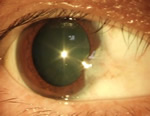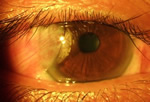
Early pterygium beginning to cover the cornea.


Pterygium
What is a pterygium? A pterygium is a raised, wedge-shaped growth of the conjunctiva (the front outer surface of the eye).
Who usually gets it?
It is most common among those who live in tropical climates or spend a lot of time in the sun. Other factors that may contribute to the formation of pterygia include allergens, noxious chemicals and irritants (e.g., wind, dirt, dust, air pollution).What are the symptoms?
Symptoms may include irritation, redness, and tearing.What are the consequences of getting a pterygium?
As the pterygium develops, it may alter the shape of the cornea, causing astigmatism. Some pterygia are very slow growing, however, in other cases the growth may be more rapid. When pterygia grow over the central cornea, vision will be affected.
How can I prevent a pterygium from growing?
Since pterygiums are most commonly caused by sun exposure, protecting the eyes from sun, dust and wind is recommended. Instilling artificial tears liberally is also helpful to decrease irritation. In some cases, steroid drops are prescribed to reduce inflammation.What is the best way of protecting the eyes?
Wearing sunglasses will protect the eyes from the effects of the sun and wind. Avoiding environments that will irritated the eyes, e.g. dusty environmnets will also protect the eyes.When should a pterygium be surgically removed?
This will depend largely on the judgment of your eye doctor. Removal will likely be advised if the pterygium is growing far enough onto the cornea to threaten your line of vision. Pterygia may also be removed if they cause a persistent foreign body sensation in the eye, or if they are constantly inflammed and irritating. In addition, some pterygia grow onto the cornea in such a way that they can pull on the surface of the cornea and change the refractive properties of the eye, causing astigmatism. Removing the pterygium may decrease the astigmatism.What is involved in the surgical removal of a pterygium?
The removal may take place in a procedure room or operating room setting. The pterygium is carefully dissected away. In order to prevent regrowth of the pterygium, the surgeon may remove some of the surface tissue of the same eye (conjunctiva) and suture it into the location of the excised pterygium. The technique of removing the pterygium without a graft is called the bare scleral technique. Patients who opt for this method may experience a high recurrence rate of the pterygium. The technique where a conjunctival graft is placed on the site where the pterygium was removed has lower recurrence rates (6 times lower rate). Postoperatively, your ophthalmologist may recommend some steroid eye drops for several weeks to decrease the inflammation and prevent regrowth of the pterygium.How long does it take?
The operation itself will take about half an hour. Some ptergiums are harder to remove and may take longer.How soon will I be able to see after the removal of pterygium?
Immediately after the removal of the pterygium, your eye will be patched for 24 hours to allow the surface of the eye to heal. When the patch is removed you will be able to see as before, however there may be times when your eye will tear just after the operation and this may result in transient blurring of vision.